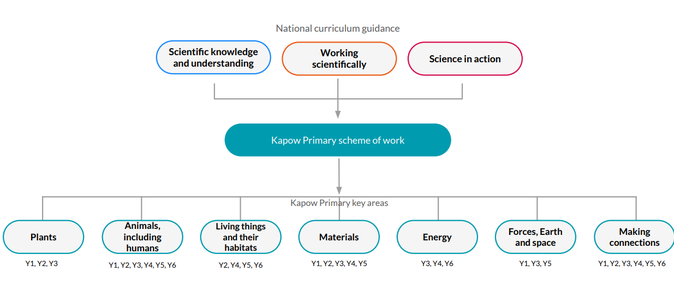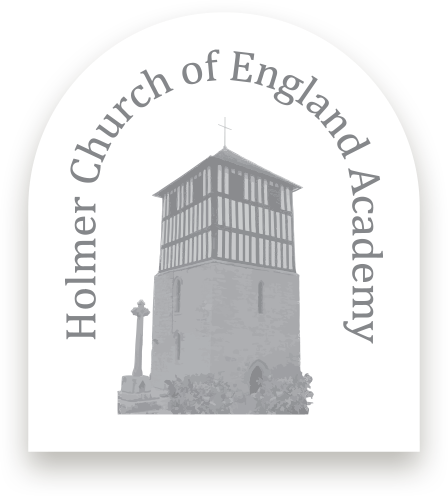Science
Science Curriculum Overview
" Inspiring us all to create a better world"
Matthew 5: 13-15 " You are the salt of the earth...you are the light of the world."
At Holmer C of E Academy, we are committed to providing a purposeful and empowering curriculum that fully prepares learners for the next steps in their school career and opens the doors to the wider world. Our curriculum meets the minimum standards as set out by the National Curriculum and looks to go beyond it to ensure that pupils leave Holmer having a strong foundation for the next step in their education journey. Kapow is used to support the delivery of teaching at Holmer C of E Academy. This is a well researched scheme and scaffolds learning to ensure a clear progression and sequenced delivery of substantive and disciplinary knowledge. Within science, we wish to provoke curiosity through the use of enquiry-based learning to help deepen children’s understanding and provide them with transferable skills that can be used across the curriculum and outside of school.
Our Science curriculum enables pupils to develop a better understanding of the world in which we live. Building on the children's knowledge and understanding of scientific methods enables them to link ideas with practical experiences and helps children to collect evidence using critical and creative thought. Children will be able to learn to question and discuss scientific issues that may affect their own lives and will help them to recognise the cultural significance of science and trace its development. A high-quality science education will help pupils gain attitudes of curiosity, originality, co-operation, perseverance, open mindedness, self-criticism, responsibility and independence in thinking. Teaching should enable children to effectively and confidently communicate their scientific predictions and discoveries as they are given the opportunity to observe, describe, illustrate, hypothesise, evaluate and interpret, using appropriate scientific vocabulary.
How is Science organised at Holmer?

Therefore all our science lessons are designed to:
-
enable children to learn about a range of living things, materials and physical phenomena.
-
allow children to make links between ideas and explain things using simple models and theories.
-
help children to think about the effects of scientific and technological developments on the environment and in other contexts.
-
carry out systematic investigations, working on their own and with others.
-
talk about their work and its significances, using a wide range of scientific language, conventional diagrams, charts, graphs and ICT to communicate their ideas.
-
learn, explore and ask questions
-
take part in practical activities which further their scientific thinking allowing them to make links in their learning.
At Holmer, we use adaptive teaching. This means teachers plan activities that enable the objective to be learned by all children including those who will find the objective challenging, those children who with hard work will secure good progress and those children who can tackle extra stretch and challenge in this subject.
The following is a guide to help you understand your child’s progression through school. The science curriculum can be broken down further into the following areas:
EYFS and KS1 - Seasons Song
The Seasons Song is a Science song that teaches the seasons of the year. The Seasons Song teaches the Spring, Summer, Fall, and Winter. Free Teaching Resourc...
KS1 - The Needs of a Plant (song for kids about 5 things plants need to live)
The Needs of a Plant 5 things plants need to stay alive
KS2 - The Eight Planets | Space Song for Kids | Solar System | Planet Song | Science Song | JunyTony
The Space, including our planet Earth and other various planets, is unknown. Let's find out what kind of planets are there, togeth...
STEM
Here are some interesting, child friendly, STEM websites that you could visit to learn more about Science, Technology, Engineering and Maths.
- https://kids.nationalgeographic.com/ The main focus of the site is animals- their appearance, behaviours, foods, and habitats. Each page offers further opportunities for your child to expand their knowledge about each creature and the world around them. There are countless videos that round out the site and some that are even entire episodes focusing on the natural world. Some of the more interactive components of the site are the quizzes, and games. The games teach basic principals like coding, geology, planetary systems and more!
- https://code.org/ Once you enter the website, you can begin coding right away. There’s no need to make an account. The “hour of code tutorials” are a great way for you to explore coding. Some of the activities on this page include making a Dance Party, building worlds on Minecraft, writing a game, programming droids, Scratch and more. A number of the activities may be completed in just 10 minutes.
- https://spaceplace.nasa.gov/ NASA Space Place is a colourful and fun website that encourages you to “explore Earth and Space!” This is a great source for anyone who is fascinated with Earth and Space. The website allows you to play games, read articles, make related crafts, and explore various activities.
- https://www.bbc.co.uk/bitesize/subjects/z2pfb9q This website covers a range of topics that we look at in school. It includes educational videos, fun Science facts and games for you to play.
Science at home!
Visit the following websites that will lead you to some amazing Science experiments that you can complete at home using equipment you can get from the supermarket!







